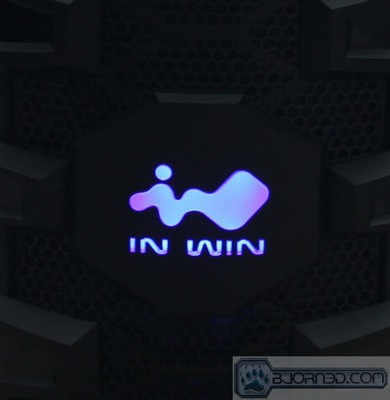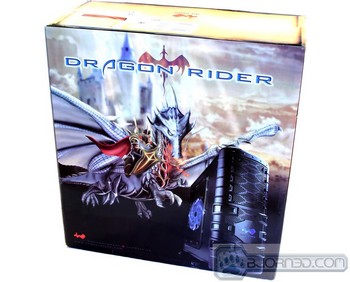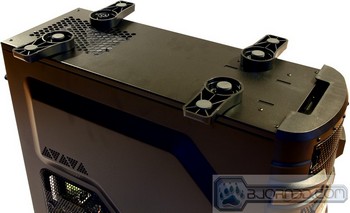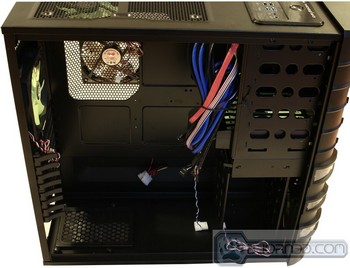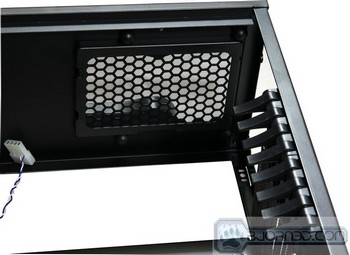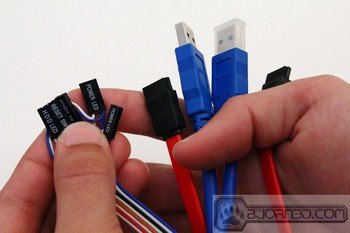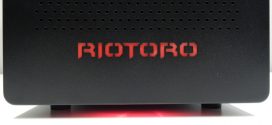Equipped with latest features, Dragon Rider is bound to satisfy any enthusiast looking to create a computer worthy of admiration.
Introduction
In-Win designed their Destiny-Extreme series chassis to appeal to the eyes of any customer. Currently, the Destiny-Extreme series consists of 6 different chassis with both futuristic and medieval themes. Aside from unique looks, all cases provide good protection and cooling performance. Tool-free structure and extreme cooling capability for overclocking is bound to atract an interest of any individual that is looking to push their PC to the max.
The In-Win Dragon Rider is priced at $159.99 at eStore USA, and $139.99 at Newegg.
The In-Win Dragon Rider is the latest case of the Destiny-Extreme series, and is designed after its predecessor: the Dragon Slayer. The meshwork and the dark design of the Dragon Rider nicely contribute to the medieval theme, while blue LEDs on the front logo and fans provide color constrast to the case.The Dragon Rider is equipped with latest ethisiast-class case features, including the eSATA and USB 3.0 front top panel ports, tool-free installation, and supports up to 12x 120mm fans.
FeaTures
|
The Dragon Rider
Inspired by the medieval age, Dragon Rider is designed to protect your components same way as the rider maneuvers his dragon to protect his castle.
Extended-ATX Motherboard Support
Built with space for any motherboard, even up to server grade E-ATX motherboard size (12 inch x 13 inch) and with enough height to support high-performance 4-way Nvidia SLI or AMD CrossFire setups (8 PCI slots).
The Ultimate Cooling Customization
Dragon Rider is equipped with ultra-large 22cm fan on one side and compatible up to 24cm radiator for liquid cooling system. The featured 12cm LED cooling fan on the other side is ensuring effective heat release from the CPU. In total, it is designed to hold up to 11 units of 12cm fans.
Easy CPU Heatsink Removal
The motherboard tray hole behind the CPU socket allows easy removal of back-mounted CPU coolers, without having to remove the motherboard.
Unique Side Panel Shield Design for Tidy Cable Management
A cable routing area behind the motherboard tray is available to keep builds tidy and to generate better system airflow.
Stable, Reliable PC Setup
The base mounted PSU to increase case stability and an included, removable fan filter protects against dust and dirt.
The Latest Enthusiast Features Included
With Super-Speed USB 3.0 front panel support and external water-cooling holes, the Dragon Rider is ready for even the most cutting edge hardware and cooling.
SPECIFICATIONS
| Specification | Dragon Rider |
|---|---|
| Case Size |
Full Tower Chassis
|
|
Internal Drive Bay
|
3.5“ x 6
|
|
External Drive Bay
|
5.25“ x 4
|
|
Top I/O Ports
|
eSATAx2
|
|
I/O Expansion Slots
|
PCI-E/PCI/AGP SlotX8
|
|
M/B Form Facto
|
ATX
|
|
Power Supply
|
ATX 12V
|
|
Thermal Solution
|
Front: 12cm Fan x 1
|
|
Dimensions (HxWxD)
|
550x225x566mm (21.7“x8.9“x22.3“)
|
|
Weight
|
Approximately 25 pounds (empty)
|
PICTures & Impressions
The In-Win Dragon Rider case by In-Win comes in a very well-designed and impressive packaging. The front of the box contains a catchy grahic of a dragon rider with a castle in the background. Pictures of the case are also portrayed on the front and back and are very well designed.
The sides of the In-Win packaging display the features and specifications of the provided case. For more information on features and specifications, please refer to the page 2 of this review. A thorough attention to design can be observed in the font of the text in which the features are written and the scroll-like background of both sides side of the packaging. Several well-taken images are provided on the features side, briefly demonstrating features like the tool-free structure of the case and the front panel containing USB 2.0, Firewire, USB 3.0, and 2 eSATA ports.
The case itself is nicely packaged, and almost impervious to possible damage during delivery. The chassis is placed in the plastic bag and secured by two large pieces of styrofoam. Bags with auxillary items and instruction manual are placed in the separate compartment between the styrofoam and the cardboard casing. The manual, provided with the case, explains gives a basic overview of installation using the tool-less features. Also, the manual goes into a fair amount of detail about all the auxillary items provided. The auxillary items include zip bands and cable clamps for cable managment, cables and support grommets for the power supply, extension cables for the fans, as well as screws for mounting of the motherboard. Although the case is supposed to be tool-less, some hardware is provided in order to mount certain devices such as the GTX 460.
The case itself is made of zinc-plated steel finished off with a fine black paint to prevent rusting. Unlike the Dragon Slayer, the Dragon Rider is a full-tower case, supports E-ATX motherboards and superior cooling capabilities. The case has 4x 120mm fans and a 220mm fan, but can easily support 12x 120m fans, creating an ideal set up for extra cooling.
Click Image For a Larger One
The frontal panel is predominantly comprised of the meshwork, providing for better ventilation. All of the meshwork, aside from the part surrounding the In-Win logo, is removable through the tab of the drive bay covers, providing access to the 5x 5.25″ drive bay. The bottom mesh can be removed to reveal the fan cooling of the hard drives. Finally, the entire front panel can be removed in order to insert the 5.25″ format drives and controllers into the slots. On the inside of the removable frontal panel, the mesh has a dust filter, which effectively prevents the dust from entering the case.
The back panel of the case contains four grommets for water cooling, which can also be used for the front panel USB 3.0 cable. There is an empty slot for motherboard ports as well the power supply which are typically found in every case. Aside from that, there are 7 bays for PCI-E devices, like graphics and USB 3.0 cards and a 120 mm exhaust fan.
Click Image For a Larger One
The right side panel contains a 120mm exhaust fan, specifically placed for drawing the hot air away from the motherboard. The steel sheet is shaped to provide enough room for cable management, but also contributes nicely to the look of the case. The left side panel contains a 220mm intake fan made specifically to cool the motherboard and related components. Entire side panel is practically made of meshwork and can accomodate up to 6x 120mm fans for better cooling. The insulation on the inside of the left-side panel is designed to mute the sound produced by the hard drives. The bottom of the case has a meshwork for the power supply fan, as well as four support legs. Support legs not only provide stability for this steel giant, but make it easier to lift the case, which is definitely a bonus, since the case alone weighs roughly 25 pounds.
Click Image For a Larger One
The front panel, with`cover removed, contains 4x 5.25″ drive bays, 1x 3.5″ drive bay, which is really a 5.25″ with removable steel FDD cage. The tool-less slide panels are positioned in one of the 5.25″ drive bay slots, but can be easily removed permanently if all 5 slots are needed. Fortunately, the steel plates blocking the other 3x 5.25″ drives can be removed with great ease and are nicely concealed by the meshwork. The fan responsible for cooling the hard drives, as well the In-Win logo LED light can also be observed on the front of the case.
The inside layout is very typical, with front of the case designed to accomodate drives and 5.25″ format devices, such as fan controllers. The back of the the case is designed for the motherboard, PCI-E devices and the power supply. The wiring of the case comes primarily from the front panel, the In-Win logo and the surrounding fans.
The motherboard panel serves a dual purpose of holding the motherboard, as well as providing cable management on the outer side of the panel. The CPU heatsink can be easily removed without displacement of the motherboard itself, if users wish to replace the thermal paste. PCI-E bays do not require hardware, and instead use the quick release clamp system in order to hold device in place. If the clamps are unable to efficiently hold the device in place, the system (4 quick release triggers) can be removed to affix the PCIe card with provided screws.The bottom of the case contains a meshwork for the power supply fan, as well as the dust filter. The fan filter is removable and can be easily cleaned, but requires the power supply to be removed.
Aside from previously mentioned 5x 5.25″ drive bays, The front panel is able to accomodate up to 6x 3.5″ hard drives, which can be used with the tool free sliding panels. These panel are made of rubber and serve a dual purpose: they hold the drive in place, and also absorb the vibrations of the spinning hard disks. Right above the hard drive space is a single slot for a solid state drive. A special platform is also provide in order to hold the drive in place.
The Dragon Rider, like the Ironclad, has a large front top panel, which provides easy access to a multitude of various ports. These ports include 2x USB 2.0, Firewire, 2x USB 3.0, Audio In/Out, 2x eSATA, as well power and reset buttons.
Assembly & Installation
While the tool free system is fairly simple and explained in detail in the manual, there are a few things unique to the Dragon Rider that must be mentioned. The tool free system is designed for the easy removal of both side panels of the case and the frontal cover mesh, as well as simple installation of drives, 5.25″ form factor devices, and PCI-E cards. These factors, as well as the diverse range of customization options, make the In-Win Dragon Rider one of the fastest assembly cases on the market and are bound to satisfy any computer enthusiast.
Removal and placement of sides and front panel panels.
Side panels are held in place by four tool free thumbscrews on the back. After removal of the screw, the panel simply slides out of the case.The front bezel is removed by simply pulling on it, and is re-mounted just as easily by applying pressure.
Placement of hard drives, SSD, and 5.25″ format devices.
As mentioned earlier, the Dragon Rider is provided with a unique system of sliding panels that secure any drive in place without tools. There are two types of sliding panels that are provided: the larger panels are designated for the 5.25″ format devices, and smaller ones for 3.5″ hard drives. Installation of the 5.25″ format devices requires the removal of the front bezel, while the hard drives can be mounted from the left side of the case. In addition to the sliding panels, the case includes a detachable bay for a solid state drive located above the hard drive section. The solid state drive is mounted from the inside of the case, and when secured, snaps the designed form in place.
PCI-E quick release system.
The PCI-E quick release system is made to accomodate any PCI-E card and can install any PCI-E card within seconds. However, special consideration should be taken towards newer graphics cards, which can not affixed by the tool free system.
Installation of the CPU cooler.
When installing larger CPU coolers, the 220mm fan on the left panel must be moved lower, or replaced with smaller 120mm fans.
FINAL PRODUCT
Test Setup
|
PC Configuration
|
|
|
Case
|
In-Win Dragon Rider
|
|
CPU
|
Intel Core i7 930 @ 3.8GHz
|
|
Motherboard
|
ASUS P6T Motherboard – LGA1366
|
|
Ram
|
Corsair 1333Mhz 6GB (3x 2GB) Kit
|
|
CPU Cooler
|
Thermalright True Black 120 with 2x Noctua NF-P12 Fans
|
|
Hard Drives
|
1x Seagate Barracuda 1TB 7200.12 Hard Drive
|
|
External Hard Drives / SSDs
|
Zalman N Series 128GB SSD
1x Seagate 7200.4 500GB Hard Drive
|
|
External Enclosures
|
In-Win AMMO USB 2.0 Enclosure
Ineo I-NA215U USB 3.0 Enclosure
|
|
Optical
|
ASUS DVD-Burner
|
|
GPU
|
Palit GTX460 Sonic Platinum 1GB GDDR5 Video Cards
|
|
Case Fans
|
3x Noctua NF-P12 120mm Fans – Side or
1x In-Win 220mm Fan-Side
1x In-Win 120mm Fans – Front, Back and Top
|
|
Additional Cards
|
Ineo I-NPC01 2 Ports PCI Express Adapter for USB 3.0
|
|
PSU
|
SeaSonic X750 Gold 750W
|
|
Mouse
|
Logitech G5
|
|
Keyboard
|
Logitech G15
|
Basic Overview
Since Dragon Rider has a similar cooling set up to the Ironclad, aside for the frontal meshwork, a similar testing as in the Ironclad was performed in order to provide conclusive results. In addition to the stock fans another set up was used in order to explore the cooling capabilities of the Dragon Rider case by replacing the 220mm fan with 3xNoctua NF-P12 120mm Fans. The hardware was tested by running stresstests using Unigine Heaven 2.1, Crysis Warhead Benchmark and Mafia II Benchmark in order to stress both the processor and the graphics card for 4 hours. File transfer data was done using bechmarks HD Tune Pro and HD Tach, but no significant change in hard drive temperature has been observed.
Results
The primary focus of testing was geared towards stressing CPU, Northbridge and the graphics card.The ambient temperature during testing were really close to the Ironclad temperature. Additionally, the pc configuation that was used during the Ironclad testing, including the processor and the graphics card, are almost identical to the test rig provided in this experiment and should provide conclusive results. Temperatures for Seagate were significantly lower than those observed in Velociraptor and can be simply explained by a significantly lower rpm in comparison to the Velociraptor. The overclocked processors in all three cases had good cooling system and demonstrated an identical temperature of 50 C. Northbridge in the stock Ironclad and Dragon Rider has an average temperature of 55 C, and is primarily cooled by the 220mm fan on the left side panel. By changing the 220mm In-Win to 3x 120mm Noctua NF-P12 fan the Northbridge runs noticably cooler. (The temperature drop is observed to be 3 C. Final GPU follows the same patterns as the Northbridge and instead of 75 C with the stock 220mm, runs at 71 C with Noctua fans.)
Exploring the alternatives
This testing has demonstrated a basic glimpse and how much the customization can affect the performance of the case. Dragon Rider, which is predominantly made of meshwork, is an ideal case for cooling due to extremely open air circulation. With ability to support up to 12x120mm fan it is a great choice for any overclocker. The opportunities certainly do not stop with the air cooling. With 4 grommets in the back of the case, and the ability of the left side panel to support 6 fans, two cooling lines can be used to achieve superior cooling performance.
Results & Conclusion
After careful analysis and rigorous testing Dragon Rider has truly lived up to its expectation and is by far the most successful full tower case in In-Win Destiny-Extreme Series. In comparison to its mini tower predecessor, the Dragon Rider impressed with its size and design. Like any full tower case, the Dragon Rider is capable of supporting E-ATX motherboards as well as extended graphics cards, like the newly released GTX 570 and 580. It is an excellent choice for any individual that wishes to create a beast out of their PC and provides the appropriate look of the top tear computer system. Blue LEDs contrast the smooth black design of the meshworks and gives this case the majestic look worthy of its price.
Aside from its looks, the Dragon Rider provides excellent cooling performance, as well as great sound insulation for the spinning hard drives, making this a worthy contender for extreme overclocking. The left side panel is comprised solely of meshwork and can support up to 6x 120mm fans. This factor, combined with the four grommets in the back of the case, allows for the support of dual water cooling system. The meshwork on the top of the case also seems to have undergone changes, and no longer contains the In-Win logo. This allows for easy placement of an external two fan radiator. The ability of the case to support two USB 3.0 and two eSATA ports on the top is yet another feature worth mentioning. Both types of ports allow for extremely fast transfer of data, and are extremely convenient in facilitating fast storage of valuable files onto external devices.
Unfortunately, it is extremely rare for a case to be perfect, and this case is no exception. While the frontal meshwork provides an excellent look, it is rather fragile, and is not able to fit the fan controllers perfectly. The steel frontal panel requires for the permanent removal of the steel plates in order to insert multiple 5.25″ form factor devices.The tool free system has a few flaws that require attention. While the slide panels are able to perfectly secure the device in the front of the case, the quick release system does not provide the necessary stability to the PCI-E cards. The quick release system does not work with extended PCI-E cards. Even with a regular PCI-E card, the quick release system does not perfectly secure the cards in place. The card is able to move from side to side, which could lead to card damage. Finally, while the top front panel provides a multitude of ports, including the USB 3.0 and eSATA, USB 3.0 is not designed to go directly into the motherboard. This is understandable, since not alot of consumers have the latest motherboards that are able to support USB 3.0 directly. But USB 3.0 wires, that are required to go through the grommets into the back of the case is slightly more than an inconvenience. Instead, it would be a great idea to provide both alternatives, the USB 3.0 extension wire and direct connection to the motherboard.
| OUR VERDICT: In-Win Dragon Rider | ||||||||||||||||||
|
||||||||||||||||||
| Summary: In-Win’s Dragon Rider case excels in both design and performance. Though it has its flaws, it is a great case made to satisfy any enthusiast that is looking to create a powerful PC. We are proud to award the Dragon Rider the Bjorn3D Bronze Bear Award. |
 Bjorn3D.com Bjorn3d.com – Satisfying Your Daily Tech Cravings Since 1996
Bjorn3D.com Bjorn3d.com – Satisfying Your Daily Tech Cravings Since 1996

